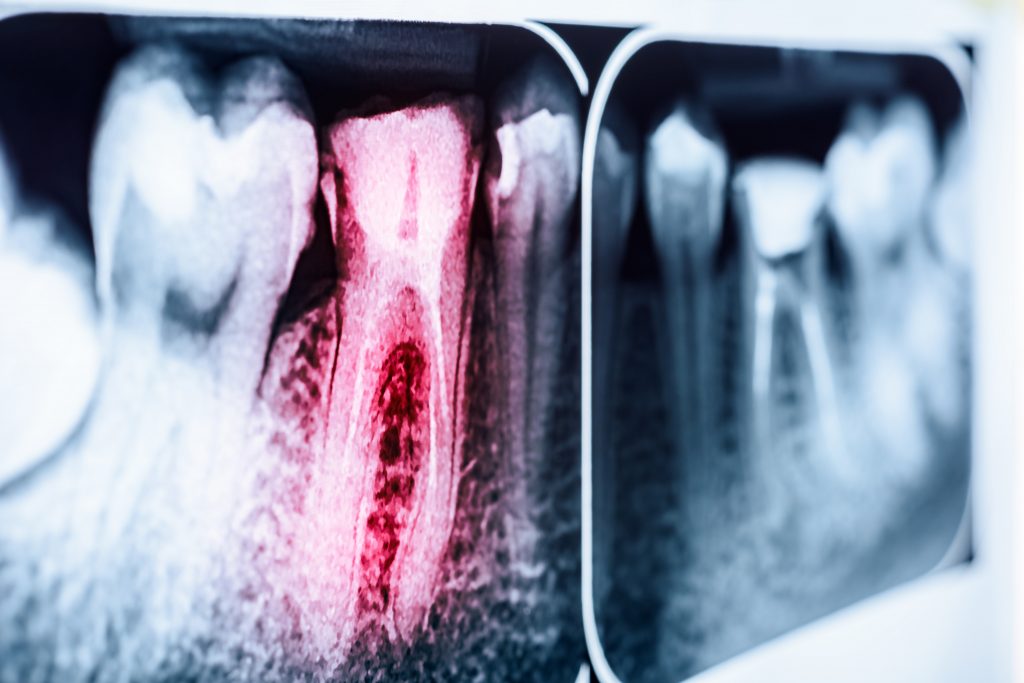
Our San Diego dentists will only recommend endodontic treatment (or root canal therapy) if you need to save a dying or accessed tooth. Root canal treatment is different from fillings, which only treat a part of the tooth or crowns which cover it completely. This treatment fills and seals off the nerve chamber inside the root of the tooth.
Root canals remove nerve and blood supply tissue that keep your tooth alive. It’s usually because the nerve and blood supply tissues are deteriorating or infected. This causes the tooth to erode from within.
While a broken, dying, or abscessed tooth is not always a problem, there are seven signs you should be aware of. If you notice any of these symptoms, you should make an appointment with Downtown Dental Specialty right away:
- Swelling and Drainage
A root canal is required when there are dental abscesses inside a tooth. The abscess is usually a small cyst that appears near the root of the tooth and can be seen on dental X-rays. You may experience side effects such as a salty taste and swelling.
Fistulas, which look like pimples on your gums, are areas of swelling around infected teeth. These fistulas are full of fluid and bacteria from the tooth. Sometimes, these fistulas can burst and cause visible or salty-tasting drainage.
- Your Tooth Has a Dark Appearance
Our teeth are porous, so it is natural for them to develop stains and discoloration over time. However, when they do, you will see a generalized change in your smile and not just in one tooth.
It’s easy for a person to spot a tooth that is changing in color. The shade changes to a brownish or greyish hue, which can affect the whole tooth. It’s usually a sign that the nerve tissues within the tooth are beginning to die or have already died.
- Sensitivity to Hot Temperatures
Sensitivity to cold temperatures is quite common. However, if a tooth reacts to heat, it is almost always a sign of nerve infection.
The tooth’s hypersensitivity to heat will usually indicate that something is wrong with the nerve tissue. An abscess, deep cavity, or severe crack could be the cause. Root canals are the only way to save your tooth from being extracted.
- A Cavity Deep Inside Your Tooth
The nerve inside your tooth is protected by a layer of enamel or dentin. If you don’t fix it immediately, decay can spread to adjacent layers or neighboring teeth. The cavity will eventually burrow through the enamel and reach the next layer, called dentin. Dentin isn’t as strong or dense, so it decays faster.
Left untreated, the cavity will quickly burrow through this softer layer, eventually reaching the nerve. Then, the nerve tissues can become infected. If the tooth was covered with a crown or filling without addressing the root, the bacteria trapped inside the nerve would cause recurring toothaches and abscesses.
- A Past Injury
Sometimes, your teeth can surprise you. If there was an injury to your mouth, the affected tooth could start to discolor and die — even if your injury happened 10 years ago. You might have been in an accident that caused your tooth to break, received a blow to the mouth from a rogue baseball, or had your child accidentally headbutt you in the mouth. It’s completely normal for teeth to discolor and die several years later, rather than at the initial time of the injury.
- Old, Leaky Fillings
Old fillings may leak or develop new areas of decay around them before you even notice it. Endodontic treatment treats the whole tooth from the inside, not just the area where the crowns or fillings are placed.
- Lingering Pain
Abscessed teeth will usually present themselves with some degree of pain. You may notice discomfort, particularly when you put pressure on the tooth, such as when you’re biting or chewing something. If you do, it’s time to call Downtown Dental Specialty.
Schedule Your Consultation
Our experienced San Diego dentists can tell you whether or not you need a root canal. If you experience any of these signs, call to schedule a checkup.


